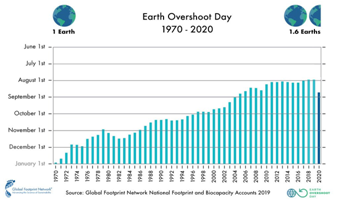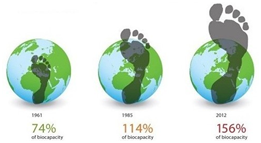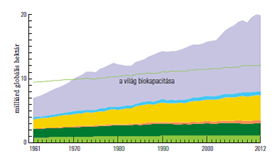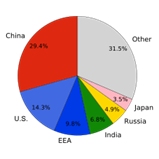Since all responsible thinking people are on the side of nature and environmental protection, many people fall for green demagoguery. This is the reason for the strengthening of green parties across Europe.
The topic is huge, I just want to point out the root of the upcoming climate catastrophe, especially the human gradation and ecological footprint. I use diagrams because they are more eloquent than any text.
The predatory management of natural resources and biocapacity is represented by the Day of Overconsumption. The attached diagram illustrates that every year since 1970, humanity has used up its available annual biocapacity earlier and earlier. In the last ten years, the world overconsumption day has been fixed at the end of July, which can be considered a partial success, because at least it has not gotten any worse. The "improvement" in 2020 was caused by the economic downturn due to the Covid epidemic, but all countries are currently working on restoring and boosting their economies. According to WWF data, July 26 is World Overconsumption Day in 2019; the European May 10; and the Hungarian one was June 14. Horrifying days of overconsumption in 2020: Luxembourg February 16; USA March 14; Canada March 18 ( https://www.overshootday.org/ ) Based on American dates, Péter Márki-Zay's reference to American environmental protection as an example to follow is ridiculous. Conclusion: we have been living the future for fifty years!

In order to identify the problem, the concept of overconsumption must first be clarified. This means that, on the one hand, natural resources and biocapacity are used at a rate greater than their renewable capacity, and on the other hand, the amount of waste emitted by the economy and society exceeds the absorption capacity of ecological systems. Examples of the first are overfishing, unprofessional forest management, degradation of agricultural land, overgrazing, waste of water, etc. A prime example of environmental pollution is the energy supply based on coal/hydrocarbons, as well as the pollution of living waters, especially the seas. The ecological footprint, which is represented by the land or water area on which the standard of living of a certain population/country/world - at a given level of technological development - can be sustained for an infinite period of time, and the waste produced by the ecological systems are able to receive it without harming the environment, is an excellent way to convey the problem of overconsumption. . According to the attached image (Earth Day Foundation), while humanity used only 74 percent of the Earth's biocapacity in 1961, humanity's ecological footprint would require 114 percent in 1985 and 156 percent in 2012. Management of the Earth's biocapacity has been published by the Global Footprint Network (Globális Ökólógia Lábnóm Hálózat, hereinafter referred to as GFN) for several decades now. According to the 2009 GFN report, while half a planet would be enough for the seven billion people at the average standard of living in India, five planets would be needed at the standard of living in the USA. But what if the population of India wants to live like the Chinese today, and the population of China like the German? The real weight of the problem is shown by the fact that 2.5 Earth globes would be needed to maintain an average standard of living in Hungary, reports the GFN in 2015. Humanity's ecological footprint also proves future compliance.

The next task is to determine how humanity's ecological footprint is distributed among large economic systems and countries. The distribution ratios between the large systems in 2019, calculated based on the attached WWF diagram, from top to bottom: carbon footprint 62%; fishing footprint 2.5%; arable footprint 20.5%; footprint of built-up areas 2.5%; forest footprint 7.5%; grazing footprint 5%. The main enemy is therefore the carbon footprint! In 2012, the sustainable carbon footprint could be as large as the arable footprint, so about 20%, instead of the actual 62%. (In the diagram, the concept of global hectare means the capacity of one hectare of average land to support people.) The big question is, what is the reality of replacing the approximately forty percent of the additional carbon footprint within the deadline? (If the situation has not worsened compared to 2012.)

The attached diagram shows the emitters of greenhouse gases. This concept also includes methane, whose greenhouse effect is much greater than carbon dioxide, and can become a dangerous factor due to the warming of the tundra and the seas. In 2016, the Paris Agreement on Climate Protection entered into force. It was signed by 194 countries, including the biggest polluters - China, the USA, the EEA (an extension of the European Union's Single Market.) and India. The purpose of the convention is to reduce greenhouse gases to such an extent that, as a result, the temperature cannot rise above 2 degrees Celsius compared to the pre-industrial revolution. The fulfillment of each country's commitments must be reported every five years. The weak point of the convention is that it has no coercive power, countries that do not fulfill their commitments are merely put on the "bench of shame". Basic question: how can recalcitrant countries be disciplined?

I would like to present the seemingly unstoppable increase in the amount of carbon dioxide in the atmosphere, as well as its causes and consequences, by examining a study taken from the Internet. (András Gelencsér, Ágnes Molnár and Kornélia Imre: Causes and consequences of climate change - 2011.) According to the study, there are three major sources of carbon dioxide entering the atmosphere. Primarily the burning of fossil fuels, followed by deforestation and agricultural soil degradation. So it is not only the energy industry that is guilty! The growth rate of emissions around the turn of the millennium was 3.4% per year, which, according to the study, had four main reasons: a return from petroleum to coal; the low efficiency of the Kyoto Convention (1992); relocation of polluting industries from developed countries to countries where there are no or soft emission restrictions; and long-distance trade has greatly increased. The reason for the latter is the mass relocation of the manufacturing industry of developed countries to Asia. The transfer of production to Asia and the increase in the volume of long-distance trade are the consequences of globalism! All of this is necessary because without an accurate diagnosis, there is no cure! The referenced study includes the accompanying astonishing chart for the period 1850-2005. The conclusions that can be drawn from the running of the diagram: there is a close correlation between the world population and the amount of carbon dioxide emissions, which is, of course, evidence; after the Second World War, both world population and carbon emissions clearly show an exponential (increasingly accelerating) function; from the end of the 1960s, the amount of atmospheric carbon dioxide – a reflection of consumption – grew significantly, separated from the population trend, and after 2000 it "skyrocketed", indicating a jump in per capita consumption. For the sake of clarity, it would be important to complete the diagram up to the present day! Based on the diagram, the reason for the upcoming climate catastrophe is that there are more and more of us on Earth and we want to consume more and more per person!

On the basis of the attached diagram (portfolio 11.07.2019), it can be concluded that the exponential growth rate of the world population has now ceased, and the world population may reach a peak of around 11 billion people around 2100. It should be emphasized that Africa's dangerous demographic explosion for Europe is brutal! At the end of 2021, the world's population is expected to reach 8 billion people, and in 2050, it is expected to reach 10 billion. Climate protection programs also count on this time frame. The big question of avoiding a climate catastrophe is, therefore, whether it will be possible to reduce the emission of greenhouse gases by 2050 at a rate greater than that resulting from the 25 percent increase in population and the additional consumption of the entire population? I have strong doubts about this. Unfortunately, the UN is on the wrong track when it wants to transfer the surplus population of the Third World to Europe and North America, with the intention of classifying migration as a human right. This is multiple dead ends. Relocation does not reduce the total consumption of the population, it actually increases it, since immigrants to rich countries immediately want to consume more. The extraction of the most educated stratum from the third world is a hidden way of colonialism, and at the same time it hinders the rise of the third world.

The Union prepared a very ambitious and expensive plan to avert the climate disaster. According to this, the EU's economy must be made climate neutral (zero carbon emissions) by 2050! To finance this program in Hungary, approximately 50,000 billion forints are needed, i.e. 170,000 forints per year for each Hungarian citizen. Approached another way, 2-2.5 percent of GDP should be devoted to this purpose every year for the next 30 years. Closer specific goals: Hungary should reduce greenhouse gas emissions by at least 40 percent by 2030 compared to the 1990 value, and increase the current share of renewable energy sources from 14 percent to at least 23 percent. Nowadays, increasing the previous expectations is on the agenda in the Union.
I have doubts as to whether the enormous financial sacrifice of the population of the Union is sufficient to avoid a climate catastrophe? First of all, I will mention the principle that only closed systems can be regulated, and the EU is only a small slice of the world economy, benefiting from only 10 percent of greenhouse gas emissions. Who will regulate the recalcitrant countries? In addition to free trade, a big question is how the rapid elimination of hydrocarbons from the Union's energy industry affects the Union's competitiveness? Another big question: is the third world capable of technological change at the appropriate pace due to its financial situation and level of technical development? Does it want to slow down its pace of catching up with Western countries in terms of consumption? Can you do this for political reasons?
By the 1970s, the system of the social market economy was established in Western Europe, of which West Germany was the leader and role model. At that time, the financial oligarchy still exercised self-control and wanted to present an attractive alternative to the citizens of the socialist world living in slavery. In the age of morality and real freedom of speech and opinion, there was still the possibility in principle for a socially friendly model change with an ecological approach. But all this fundamentally changed after the collapse of the socialist world order, capital immediately showed its white teeth. Incredibly quickly, a neoliberal economic philosophy came to dominate the entire world. The essence of this is the philosophy of infinite development with a finite set of resources, regardless of its social and ecological consequences. The morality of this world order is excellently illustrated by the defense of György Soros in the French court, when the judge called his attention to the social damage he caused. Soros' defense:
"As a market participant, I don't have to worry about the consequences of my actions."
Somewhere earlier, I read the insightful statement that Anglo-Saxon economists in the XX. At the beginning of the 20th century, morality was banished from economics, and economics was reduced to a science reduced to utility. In addition to the population explosion, this is another basic problem of our time! The neoliberal economic policy is extremely immoral, and for this reason I do not believe in its reformability.
The study I used as a source outlined some scenarios depending on political, economic, demographic and technological variables. If everything continues as it has been, the atmospheric carbon dioxide concentration may well exceed 800 ppm in 2100. (Before the industrial revolution, this value was 280 ppm, and today it is already over 400 ppm.) In the case of the rapid degradation of globalization and the spread of local consumption, the carbon dioxide concentration may be around 600 ppm in 2100. The other models run between these two values. Meteorologists could estimate the extent to which the carbon dioxide concentration values in question induce climate change. Based on this estimate - at least for the two scenarios indicated above - an action plan should be drawn up for each country with the involvement of ecologists, economists, social scientists and politicians!
Unfortunately, I do not see a coherent program from the green parties, neither in the Union nor in our country, which aims to remedy the root of the problem in a holistic approach, with an appropriate schedule. The green parties ignore the fact that the carbon dioxide released into the atmosphere is only an effect and not the cause of the problem!
The real reason is the population explosion, human gradation, and the consumer society as an economic model!
This evidence must be stated because in today's public discourse, population explosion, and especially state intervention in demographic conditions, as a cure for the problem, is considered a taboo, and anyone who tries to discuss this is immediately branded a Nazi. But what force will force a change in the economic model when there is no new model yet? Or do the greens want to transform the consumer society into a green one without changing the model? Is there any reality to this? Isn't that a wooden iron ring?
Looking at the sub-problems, the greens are against nuclear energy, while the fact that the military technology already has as much nuclear energy as is sufficient to destroy humanity many times over is beyond their scope. The greens can't even answer the basic question that if atoms and hydrocarbons are undesirable, what can base power plants be based on? In Germany, the closure of the nuclear power plants led to a brutal increase in prices, which seriously threatens the competitiveness of the German economy. Unfortunately, we cannot expect anything good from the Greens who came to power in the new government, and this will affect the entire Union. Due to the ill-considered EU green policy, energy supply disruptions are expected in the West in winter. And energy prices are skyrocketing due to the energy chaos/energy shortage caused by green politics, not the increase in production costs!
Péter Márki-Zay therefore protects the extra profit of the multinationals that own the energy sources!
I have a bad feeling that doctrinaire green politics is just a new front in the war against the white man in Europe! The goal is to increase the chaos.
The LMP wants to appropriate the green policy in our country. At the same time, its politicization is inherently discredited, as it has become a satellite party of DK, which is a domestic servant of globalist interests. Environmental activist Erzsébet Schmuck, politician and economist by profession, repeats herself like a mantra: the Orbán government is doing too little to avert the climate emergency and make our domestic energy use carbon neutral. On the one hand, the female politician is silent on Hungary's efforts so far, on the other hand, she could only be more credible if she immediately left the "washing coalition" protecting globalist interests. Following this, an expert group should be formed in order to clarify the issues raised above. Mayor Gergely Karácsony's performance in this regard is pathetic. After taking office, he immediately declared a climate emergency in Budapest, but what did he do about it? Bees are needed in the countryside for pollination, not in the middle of a big city. It is also certain that it is unhealthy and dangerous to ride on painted bicycle paths between car lanes, and it is likely that the slowing down of traffic has worsened the air quality of the city center. And in the winter, who will cycle on the cycle paths that are hardly used even in the summer? And now the property of the protected Mocsárosdűlő has come to light.
The socio-economic-political danger of the green demagogy dominating the Union lies in the fact that their hasty program is not suitable for averting the truly threatening ecological catastrophe, and on the other hand, the people of Europe - disappointed in the people's parties and the socialist parties - defect in good faith to the greens, not realizing that the "Trojan left-liberal, globalist soldiers are hiding in "falo".
Pál Bartha is a retired forest engineer
Featured Image: Pixabay












